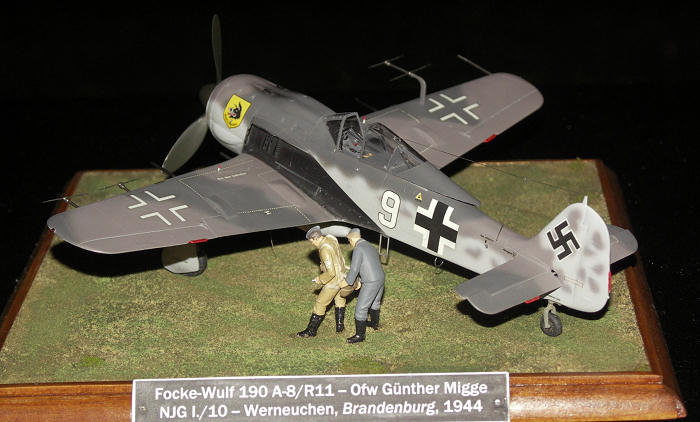
Trimaster 1/48 FW-190A-8/R11
| KIT #: | MA7 |
| PRICE: | about $50 18 years back |
| DECALS: | Two options |
| REVIEWER: | Patrick Grué |
| NOTES: | ICM figurines used for the diorama |

| HISTORY |
At the end of 1940, the night bombing raids carried out by the RAF over Germany were considered as a serious threat and called for the creation of a night fighter task force. Wolfgang Falk, an experienced Bf-110 pilot, was in charge of putting into operation the first night fighter unit. At this time, the aircraft available for these night operations were Bf-110, Ju-88 and Do-217 twin-engine. These aircraft were day-combat version converted into night-combat version with minor modifications such as exhaust pipe flame dampers, addition of landing lights and an appropriate camouflage. These night birds of prey could fly blind at night towards a moving target only with the assistance of ground radar stations until visual contact with enemy. Furthermore, visual contact was made possible by illumination of the foe bombers thanks to the FLAK searchlights. This tactic so called Helle Nachtjagd (illuminated night fight) gave satisfaction if the cloud coverage was below 60% and the target could be illuminated from the ground. Otherwise, target acquisition was difficult or even impossible.
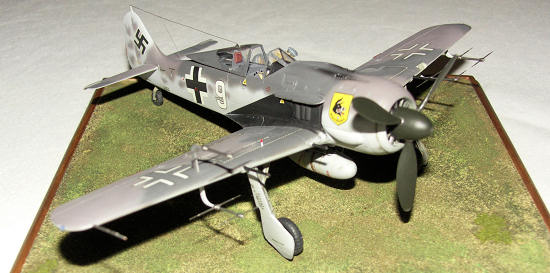 To cover most of the meteorological situations, solution was the Airborne
Interception Radar which was introduced during spring of 1942 with the
Lichtenstein radar. In addition of that, Germany had developed a radar
To cover most of the meteorological situations, solution was the Airborne
Interception Radar which was introduced during spring of 1942 with the
Lichtenstein radar. In addition of that, Germany had developed a radar
The disastrous fire storm on Hamburg during the night bombing of 24 July 1943 challenged night fighting techniques. The radar interception system failed for the first time because of a new countermeasure device used by the British bombers: the chaffs. Nicknamed windows , they were made of 27 cm by 2 cm aluminium strips cut to one-half of the Würzburg wavelength (560 MHz; 53.6 cm). They were dropped in bundles of 2,000 from bombers with one-minute intervals. These metallic clouds jammed the ground radar by reflecting different frequencies, so as to create a large area of false returns which either appeared as a cluster of secondary targets on a radar screen or saturated the screen with multiple returns. As a consequence German radars were not able to give the night fighters the real bearing they required.
In response to this, a new tactic called Wilde Sau (Wild boar) was developed by Hajo Herrmann, a highly decorated bomber pilot, to cope with the lack of efficient ground guidance. The principle consisted in the use of single-engine day fighters such as Bf-109 and Fw-190 to reinforce the twin-engine night fighter units. They were radio-guided approximately to the area where bombers and chaff clusters were greatest, then the fighter pilots were alone in their free-ranging interception until visual acquisition of their target. This tactic was similar to the Helle Nachtjagd , without real ground assistance excepted that the fighters needed to have the sky as bright as possible around the bomber stream. That was able by FLAK searchlights, fire light of bombing itself (a paradox situation!) and by Ju-88s dropping parachuted flares above the bombers to illuminate them.
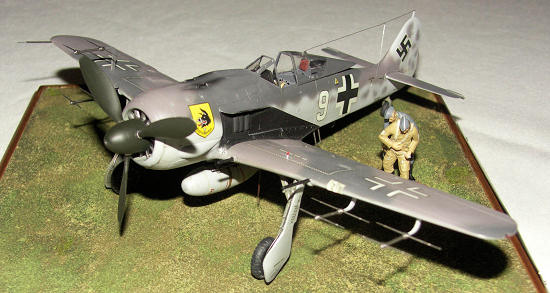 JagdGruppen 300, 301 and 302 were the newly formed units to carry out this
difficult task. The pilots of these units had to be familiar with blind
navigation at night in addition of the target tracking workload. Accidents such
as collision and lost of horizontal reference were frequent with aircraft not
really dedicated to this task.
JagdGruppen 300, 301 and 302 were the newly formed units to carry out this
difficult task. The pilots of these units had to be familiar with blind
navigation at night in addition of the target tracking workload. Accidents such
as collision and lost of horizontal reference were frequent with aircraft not
really dedicated to this task.
As the British knew the frequencies of the most ground and airborne radar used, the Germans started researches in new radar technology, for instance the use of multi-frequency on the same equipment and the use of centimetre wavelengths.
Neptun FuG 217 and FuG 218 radar were developed to this end. Both of them could be installed in single-engine fighters (FuG 217-J2 or FuG 218-J3 versions) and in twin-engine fighters (FuG 217-R2 or FuG 218-R3 versions).
FuG 217 could operate with two frequencies: 158 MHz or 187 MHz, with an efficient range detection from 400 m to 4,000 m. Its aerials were made of single masts arranged vertically in rows over the top centreline of the fuselage in front and behind the canopy, and on the wings extrados.
FuG 218 was an enhanced version of the previous one. It could operate with six frequencies selected within 158 MHz and 187 Mhz band, with an efficient range detection from 120 m to 5,000 m. Its aerials were made of two pairs of rake antennas fitted on the leading edge of each wing.
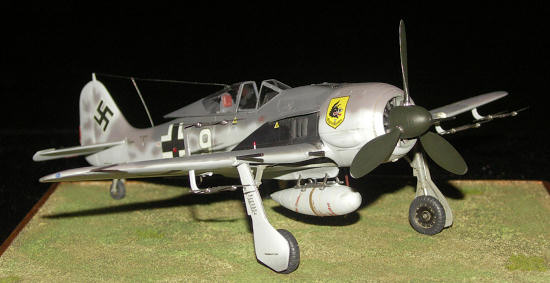 The Focke-Wulf 190 A6 and A8 were good platforms for testing the Neptun
radar. My model is the version fitted with the FuG 218-J3 radar used in NJG 10,
an experimental unit dedicated for testing the various night fighting
techniques. Each FW-190 fitted with a Neptun featured a radar screen on its
instrument panel. Its standard armament was four 20 mm cannons and two 13 mm
machine guns. A 300 litre drop tank was always carried due to the long time
missions the pilots bore. Two flame dampers and a landing light were installed.
The wild boar emblem was typical of these single-engine night fighter units, and
the Kognak Pumpe tag referred to the need of drinking after each mission!
The Focke-Wulf 190 A6 and A8 were good platforms for testing the Neptun
radar. My model is the version fitted with the FuG 218-J3 radar used in NJG 10,
an experimental unit dedicated for testing the various night fighting
techniques. Each FW-190 fitted with a Neptun featured a radar screen on its
instrument panel. Its standard armament was four 20 mm cannons and two 13 mm
machine guns. A 300 litre drop tank was always carried due to the long time
missions the pilots bore. Two flame dampers and a landing light were installed.
The wild boar emblem was typical of these single-engine night fighter units, and
the Kognak Pumpe tag referred to the need of drinking after each mission!
However single-engine fighters were progressively withdrawn from night fighter units to be enrolled in their original task, i.e. day combat against US bombers. Twin-engine/ two-seater aircraft were in fact better suited for these stressing missions since the workload could be shared between the pilot and his radar operator. Entry into operation of aircraft well equipped for this task such as Bf 110G-4, He 219 and Me 262B put an end to the Wilde Sau tactic.
And then electronic warfare was born...
| THE KIT |
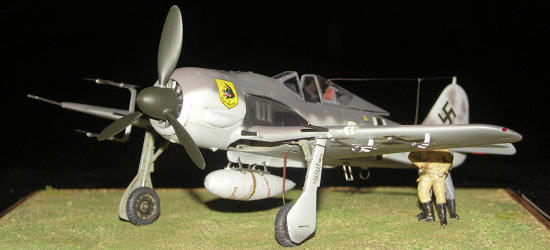 When Japanese manufacturer Trimaster released 20 years ago its WWII German
fighter s collection in 1/48 scale, many modelers and retailers blessed these
kits and qualified them as kits of the century ! However their prices were at
the level of the advertisement effect they gave (very expensive), mostly because
of the first use of numerous metallic parts and details.
When Japanese manufacturer Trimaster released 20 years ago its WWII German
fighter s collection in 1/48 scale, many modelers and retailers blessed these
kits and qualified them as kits of the century ! However their prices were at
the level of the advertisement effect they gave (very expensive), mostly because
of the first use of numerous metallic parts and details.
There are 120 parts: 74 parts in grey plastic, 6 in transparent plastic, 27 in photo-etched steel, 8 in pewter for the landing gear and seat, 5 parts of tubes and wires in brass for the guns and radar antennas. Two pilots are given, one in stand up position and another in sitting position, but they are poorly molded and might be replaced by a more recent release. There is one decal sheet for one option. When looking at the plastic and metallic parts, it seems to be a nicely detailed kit.
| CONSTRUCTION |
All comes easily and there is no real tricky point except that the wings and fuselage root needs a lot of putty. The whole gear parts are in pewter which is not a good idea because it needs to be fixed using instant glue, so the delay for adjustment is very short. The FuG 218 antennas are a bit touchy to build: the small diameter tubes flatten out at tip ends when cutting them, which prevents the very small wires from being inserted and glued inside the tubes. Either holes must be enlarged with a needle in steel after cutting, or the tubes must be cut carefully with slow rotational movements. Be patient, the result is worth the effort.
| COLORS & MARKINGS |
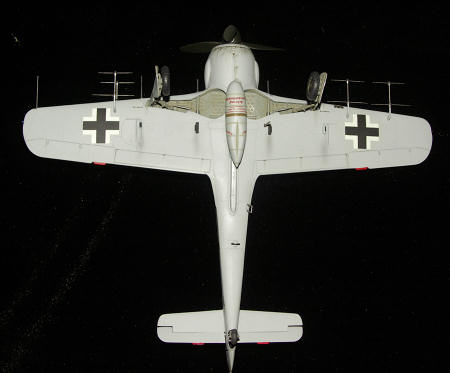 I used Humbrol enamel #125 for RLM 66 cockpit interior with a final dry-brush
of silver powder to give a metallic aspect. All belts are beige.
I used Humbrol enamel #125 for RLM 66 cockpit interior with a final dry-brush
of silver powder to give a metallic aspect. All belts are beige.
The wheel wells and gear legs are in RLM 02 grey-beige. The propeller blades and spinner are in RLM 70 black green. The antennas are in painted in steel.
The decal sheet suggests only one option marking: the white 9 flown by oberfeldwebel G
ünther Migge in 1944 when he was transferred to the first group of NJG 10 at Werneuchen airfield (Northeast of Berlin).The camouflage scheme is of the day-combat type, i.e. RLM 74 grey-green/ RLM 75 grey-violet over RLM 76 light grey-blue. I started to airbrush the lower surfaces in RLM 76 using Gunze acrylic paints. Then all the upper surfaces were airbrushed free hand in RLM 74/75, and the mottling in RLM 75.
| CONCLUSIONS |
| REFERENCES |
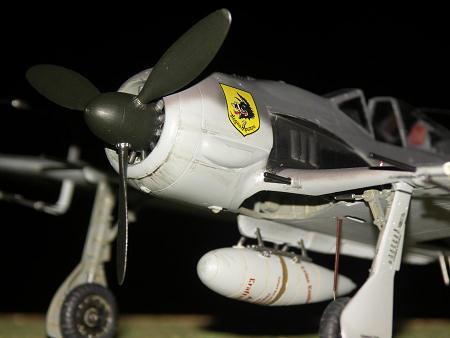 Wikipedia Wapedia (2009)
Wikipedia Wapedia (2009)
IPMS Stockholm (2006): Focke-Wulf Fw 190 A-8/R11 Nachtjäger
January 2010
If you would like your product reviewed fairly and quickly , please contact me or see other details in the Note to Contributors.